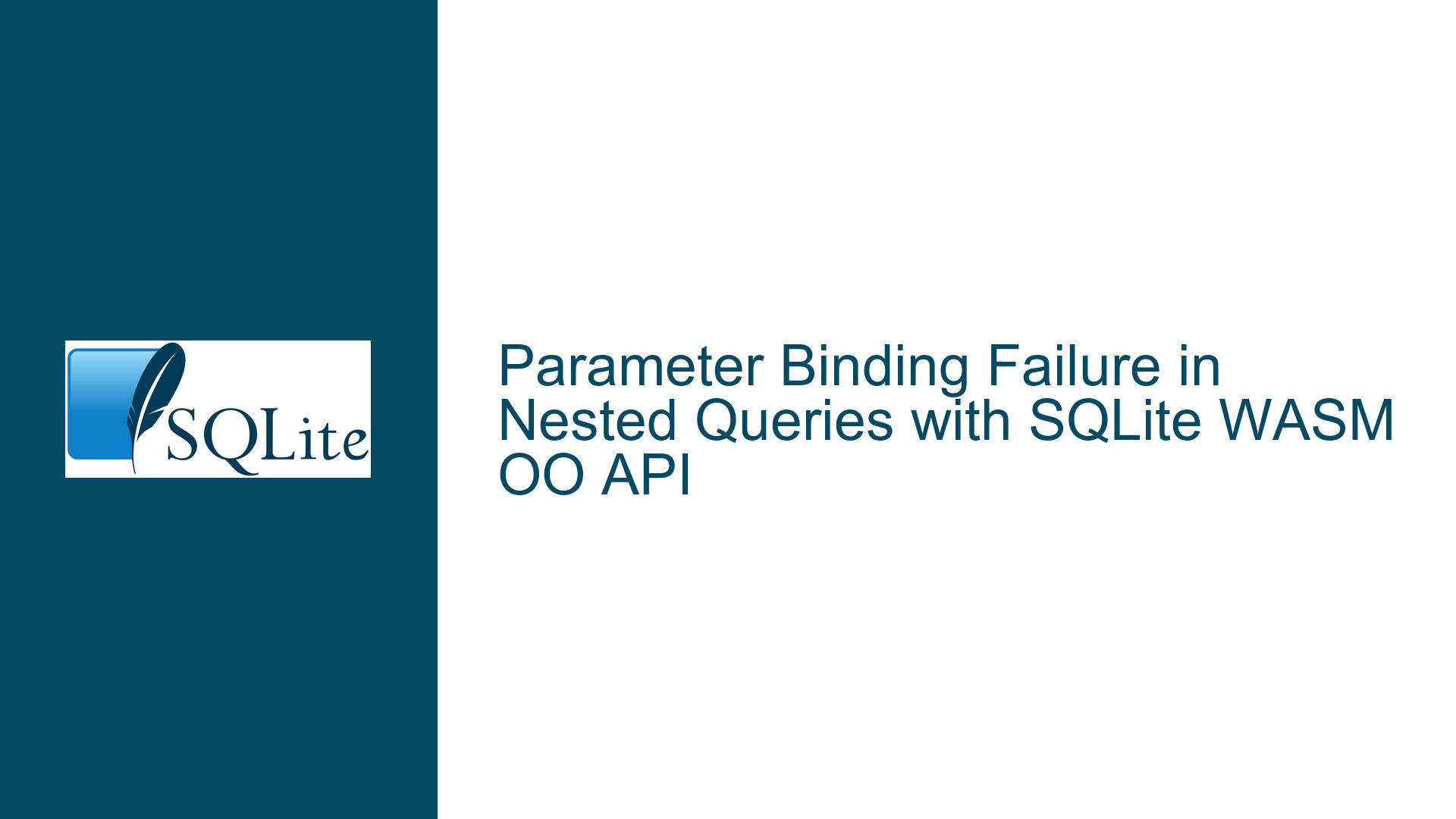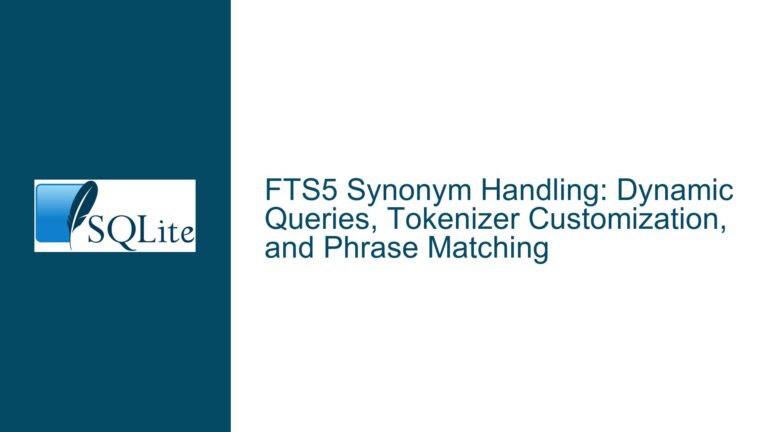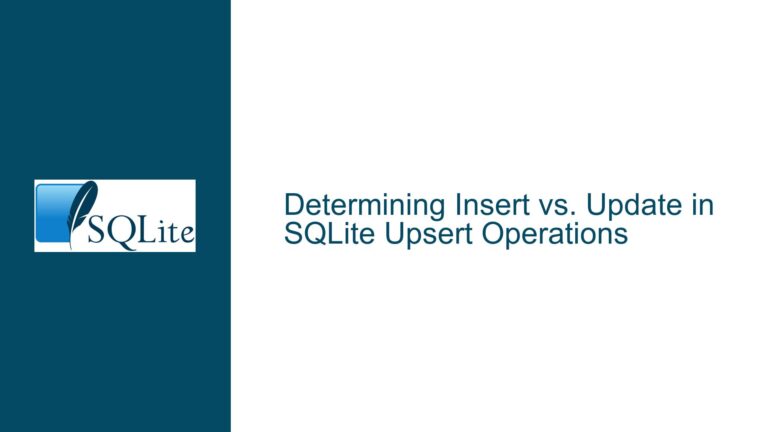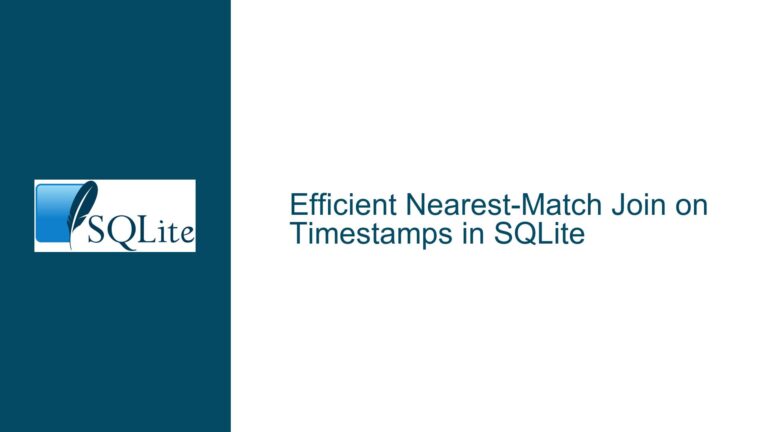Parameter Binding Failure in Nested Queries with SQLite WASM OO API
Issue Overview: Parameter Binding in Nested Queries with External Content Tables
The core issue revolves around the failure of parameter binding in nested SQL queries when using SQLite’s WASM Object-Oriented (OO) API. Specifically, the problem manifests when attempting to delete records from a table (Item) based on a subquery that references a Full-Text Search (FTS5) table (ItemFts) configured with external content. The FTS5 table is set up to use the Item table as its external content source, meaning that the FTS5 table does not store its own data but instead references the data in the Item table.
The query in question is structured as follows:
DELETE FROM Item WHERE rowid IN (
SELECT rowid FROM ItemFts WHERE path = :path
)
Here, the :path parameter is intended to be dynamically bound to a value provided at runtime. However, the query fails to delete the expected records, even though the parameter binding appears to be correctly specified in the code. This issue is particularly perplexing because simpler queries, such as direct deletions using hardcoded values or non-nested parameterized queries, work as expected.
The problem is further complicated by the use of the WASM OO API, which introduces an additional layer of abstraction over SQLite’s C API. This API is designed to simplify interactions with SQLite in web environments by providing a more JavaScript-friendly interface. However, this abstraction can sometimes obscure underlying issues, making it difficult to diagnose problems related to parameter binding and query execution.
Possible Causes: Misconfiguration and API Misuse
Several potential causes could explain the observed behavior. The first and most straightforward possibility is a misconfiguration in the parameter binding syntax within the WASM OO API. The API requires a specific structure for passing parameters, and any deviation from this structure can result in binding failures. In this case, the user initially attempted to bind parameters using an incorrect syntax:
db.exec(`...`, {":path": path})
This syntax is incorrect because it does not conform to the expected structure for parameter binding in the exec method. The correct syntax requires the use of a bind object nested within the options object:
db.exec(`...`, { bind: {":path": path} })
The incorrect syntax likely resulted in the parameters not being properly bound to the query, causing the subquery to fail silently.
Another potential cause is related to the use of external content in the FTS5 table. When an FTS5 table is configured to use external content, it does not store its own data but instead references data in another table. This setup can introduce complexities in query execution, particularly when nested queries are involved. The FTS5 table must correctly resolve references to the external content table, and any misconfiguration or unexpected behavior in this resolution process could lead to query failures.
Additionally, the issue could be related to the way the WASM OO API handles parameter binding in nested queries. While the API is designed to be a thin wrapper around SQLite’s C API, there may be edge cases or subtle differences in behavior that are not immediately apparent. For example, the API might handle parameter binding differently in nested queries compared to simple queries, leading to unexpected results.
Finally, it is worth considering the possibility of a bug in the WASM OO API itself. While the API is generally reliable, it is still a relatively new and evolving component of SQLite. Bugs or limitations in the API could potentially cause issues with parameter binding, particularly in complex query scenarios.
Troubleshooting Steps, Solutions & Fixes: Diagnosing and Resolving Parameter Binding Issues
To diagnose and resolve the parameter binding issue, it is essential to follow a systematic approach that addresses each of the potential causes outlined above. The following steps provide a detailed guide for troubleshooting and fixing the problem.
Step 1: Verify Parameter Binding Syntax
The first step is to ensure that the parameter binding syntax is correct. As noted earlier, the WASM OO API requires a specific structure for passing parameters. The correct syntax for binding parameters in the exec method is as follows:
db.exec(`...`, { bind: {":path": path} })
If the syntax is incorrect, the parameters will not be properly bound to the query, leading to unexpected results. To verify that the syntax is correct, carefully review the code and compare it to the expected structure. If necessary, consult the API documentation to confirm the correct usage.
Step 2: Test Parameter Binding in Isolation
Once the syntax has been verified, the next step is to test the parameter binding in isolation. This can be done by executing a simple query that uses parameter binding and verifying that the parameters are correctly bound. For example:
db.exec(`SELECT * FROM Item WHERE path = :path`, { bind: {":path": path} })
If the query returns the expected results, it confirms that the parameter binding is working correctly. If the query fails or returns unexpected results, it indicates a problem with the parameter binding mechanism.
Step 3: Test the Subquery in Isolation
After confirming that parameter binding works in simple queries, the next step is to test the subquery in isolation. This involves executing the subquery separately and verifying that it returns the expected results. For example:
db.exec(`SELECT rowid FROM ItemFts WHERE path = :path`, { bind: {":path": path} })
If the subquery returns the expected row IDs, it confirms that the subquery is functioning correctly. If the subquery fails or returns unexpected results, it indicates a problem with the subquery itself, possibly related to the use of external content in the FTS5 table.
Step 4: Verify FTS5 Table Configuration
If the subquery fails, the next step is to verify the configuration of the FTS5 table. Specifically, ensure that the FTS5 table is correctly configured to use the Item table as its external content source. This involves checking the table creation statement to confirm that the content option is correctly specified. For example:
CREATE VIRTUAL TABLE ItemFts USING fts5(path, content=Item);
If the content option is missing or incorrectly specified, the FTS5 table will not be able to correctly resolve references to the Item table, leading to query failures.
Step 5: Test the Full Query with Hardcoded Values
To further isolate the issue, test the full query with hardcoded values instead of parameter binding. For example:
db.exec(`DELETE FROM Item WHERE rowid IN (
SELECT rowid FROM ItemFts WHERE path = 'some/hard/coded/path'
)`)
If the query successfully deletes the expected records, it confirms that the query structure is correct and that the issue is related to parameter binding. If the query fails, it indicates a problem with the query itself, possibly related to the use of external content in the FTS5 table.
Step 6: Review API Documentation and Known Issues
If the issue persists, review the API documentation and any known issues related to the WASM OO API. The API documentation may provide additional insights into the correct usage of parameter binding and any potential limitations or edge cases. Additionally, check the SQLite forum and other community resources for reports of similar issues. If the issue is a known bug or limitation, there may be workarounds or fixes available.
Step 7: Debugging with Console Logs and Error Handling
To further diagnose the issue, add console logs and error handling to the code to capture any errors or unexpected behavior. For example:
try {
db.exec(`...`, { bind: {":path": path} })
} catch (error) {
console.error('Query execution failed:', error);
}
This can help identify any errors or exceptions that occur during query execution, providing additional clues about the root cause of the issue.
Step 8: Simplify the Query Structure
If the issue is still unresolved, consider simplifying the query structure to isolate the problem. For example, break the query into smaller parts and execute them separately. This can help identify which part of the query is causing the issue. For example:
const rowIds = db.exec(`SELECT rowid FROM ItemFts WHERE path = :path`, { bind: {":path": path} });
db.exec(`DELETE FROM Item WHERE rowid IN (${rowIds.join(',')})`);
By breaking the query into smaller parts, it may be easier to identify and resolve the issue.
Step 9: Consult the SQLite Community
If all else fails, consider consulting the SQLite community for assistance. The SQLite forum is a valuable resource for getting help with complex issues. When posting a question, provide as much detail as possible, including the full schema, sample data, and the exact code being used. This will help others reproduce the issue and provide more accurate and helpful responses.
Step 10: Consider Alternative Approaches
If the issue cannot be resolved, consider alternative approaches to achieve the desired result. For example, instead of using a nested query, execute the subquery separately and then use the results to perform the deletion. This approach may be less efficient but can help work around any limitations or bugs in the API.
By following these steps, it should be possible to diagnose and resolve the parameter binding issue in nested queries with the SQLite WASM OO API. The key is to approach the problem systematically, verifying each component of the query and the API usage to identify and address the root cause of the issue.






